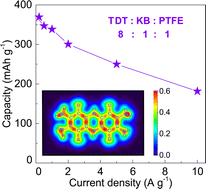A semi-conductive organic cathode material enabled by extended conjugation for rechargeable aqueous zinc batteries†
Abstract
Quinone cathode materials show great promise for aqueous zinc batteries. However, the poor electrical conductivity of organic compounds calls for the addition of high percentages of conductive agents during electrode preparation, usually ≥30%. Herein, we synthesize a semi-conductive piperazine-linked quinone of 2,3,7,8-tetraamino-5,10-dihydrophenazine-1,4,6,9-tetraone (TDT) for zinc batteries. Theoretical calculations suggest the extended conjugation among the π-electrons on the quinone rings and p-electrons on nitrogen sites in the structure. This allows electron delocalization throughout the entire molecule, and a small band gap of 1.5 eV is revealed by theoretical calculations and solid-state UV-vis spectroscopy. Besides, electron paramagnetic resonance demonstrates the formation of cationic radicals on the nitrogen of the middle piperazine ring. The radical is also stabilized by the extended conjugated system and further enhances the electrical conductivity. Thanks to the above factors, TDT exhibits a good electrical conductivity on the order of 0.1–1 mS cm−1. In aqueous zinc batteries, the TDT cathode with 10% carbon delivers a high capacity of 369 mA h g−1 at 0.2 A g−1 and retains 182 mA h g−1 at 10 A g−1. In situ UV-vis analysis further reveals the insolubility of TDT at all charged/discharged states, which ensures stable cycling for 3000 cycles.



 Please wait while we load your content...
Please wait while we load your content...